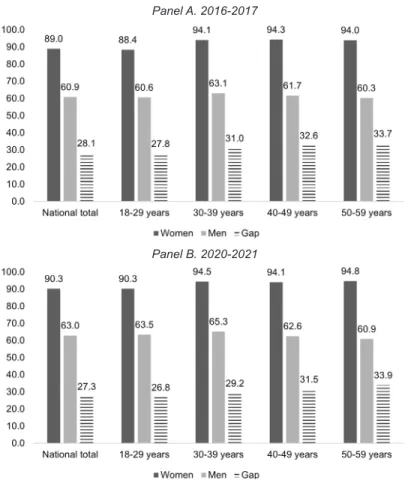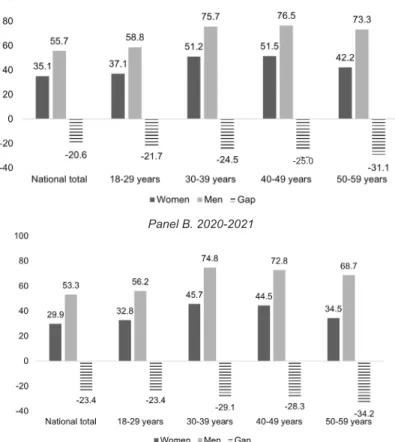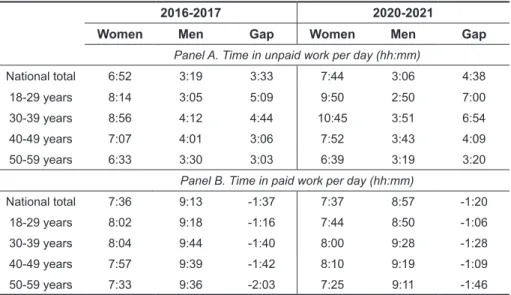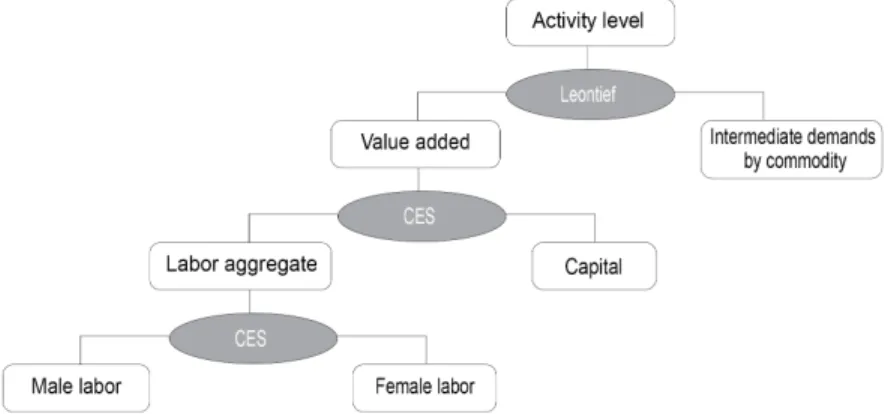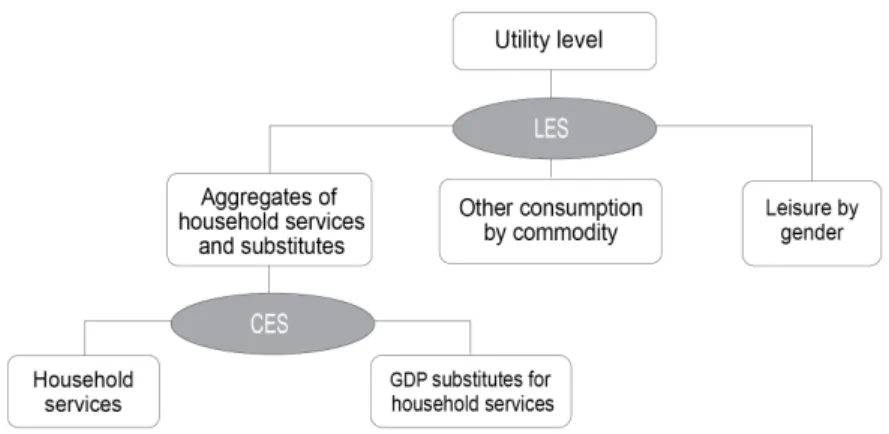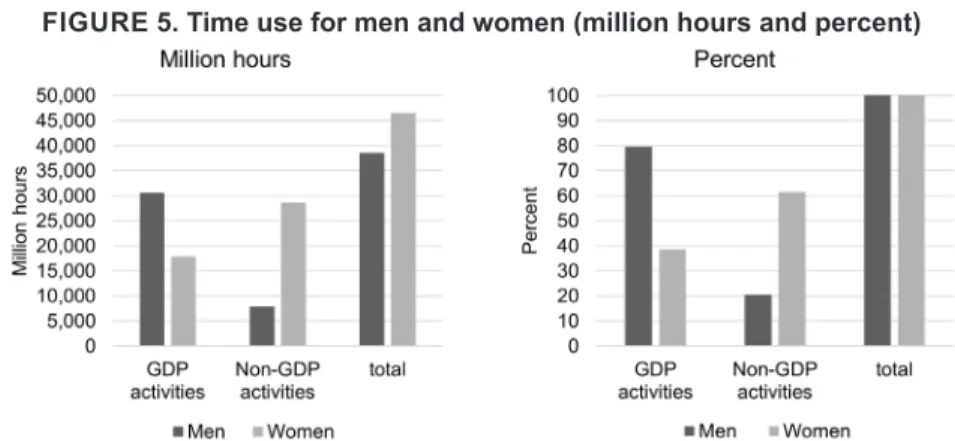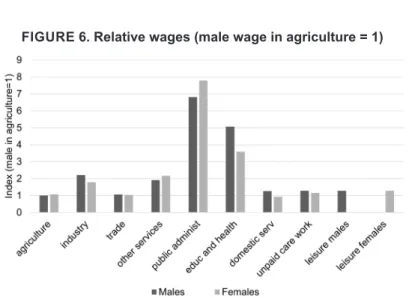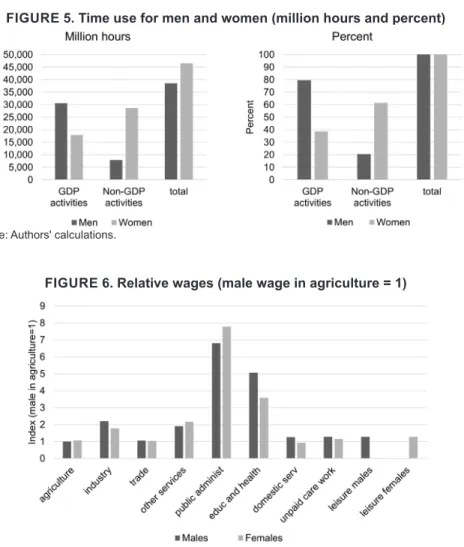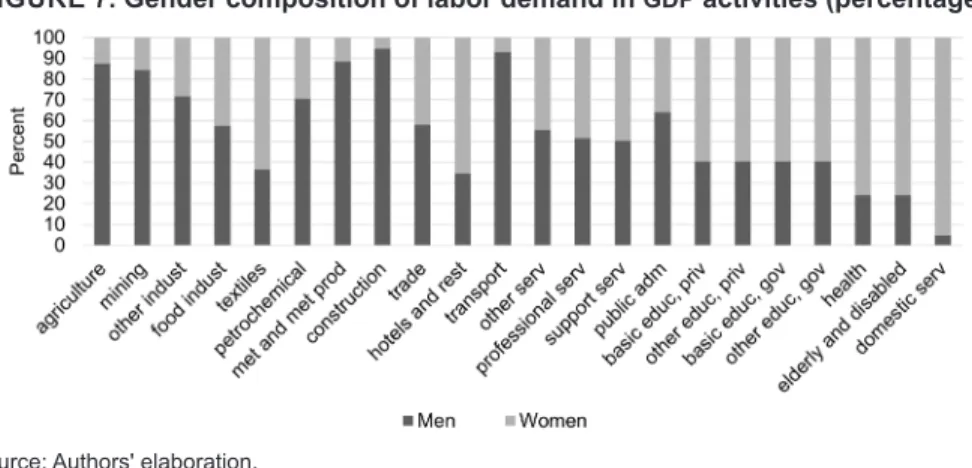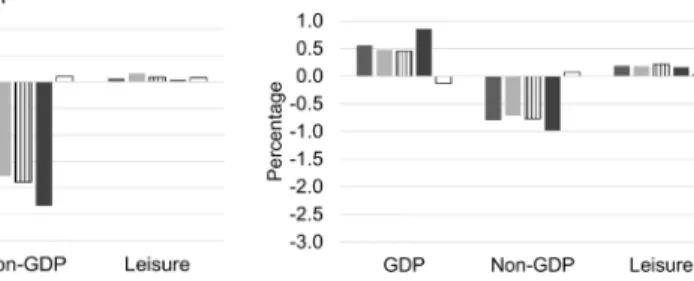The Philippine Review of Economics
Editor-in-Chief EMMANUEL F. ESGUERRA
Editorial Advisory Board EMMANUEL DE DIOS
RAUL V. FABELLA HAL CHRISTOPHER HILL
CHARLES Y. HORIOKA KIAN GUAN LIM ROBERTO S. MARIANO JOHN VINCENT C. NYE GERARDO P. SICAT JEFFREY G. WILLIAMSON
Associate Editors LAWRENCE B. DACUYCUY FRANCISCO G. DAKILA JR.
JONNA P. ESTUDILLO MARIA S. FLORO GILBERTO M. LLANTO
Managing Editor HONLANI RUTH R. RUFO
A joint publication of the University of the Philippines
School of Economics and the Philippine Economic Society
ARTICLES IN THIS ISSUE Unemployment and monetary policy:
a revisit and new job strategies Dante B. Canlas
A SYMPOSIUM ON THE CARE ECONOMY Introduction to the symposium on
the care economy Maria S. Floro
Elizabeth M. King Child and elderly care in South Korea:
policy analysis with a gendered, care-focused computable general equilibrium model
Martín Cicowiez Hans Lofgren
Women’s market work and childcare policies in Colombia: policy simulations using a computable general equilibrium model
Martín Cicowiez Hans Lofgren Ana Tribin Tatiana Mojica The enduring impact of the
pandemic on gender patterns of paid and unpaid work: evidence from time-use data in Turkey
Ipek Ilkkaracan Emel Memiş
Unpaid eldercare and its impact on
the US labor supply Tanima Ahmed
Maria S. Floro Care work and the demographic
composition of households: two Asian cases
Elizabeth M. King Hannah L. Randolph Jooyeoun Suh Care workers’ sense of responsibility,
working conditions, and the quality of care in South Korea
Shirin Arslan Arnob Alam Maria S. Floro Seung-Eun Cha Eunhye Kang
Aims and Scope: The Philippine Review of Economics (pre) invites theoretical and empirical articles on economics and economic development. Papers on the Philippines, Asian and other developing economies are especially welcome. Book reviews will also be considered.
The pre is published jointly by the up School of Economics and the Philippine Economic Society. Its contents are indexed in the Journal of Economic Literature, EconLit, and RePEc.
pre’s readership includes economists and other social scientists in academe, business, government, and development research institutions.
Publication Information: The pre (issn 1655-1516) is a peer-reviewed journal published every June and December of each year. A searchable database of published articles and their abstracts is available at the pre website (http://pre.econ.upd.edu.
ph).
Subscription Information:
Subscription correspondence may be sent to the following addresses:
• pssc Central Subscription Service,
psscenter, Commonwealth Avenue, 1101, Diliman, Quezon City, Philippines.
P.O. Box 205, up Post Office, Diliman, Quezon City, Philippines 1101
PHONE: 922-9627, FAX: 924-4178/926-5179
Submissions: Authors may submit their manuscripts to addresses below:
• [email protected] or [email protected]
• The Editor, The Philippine Review of Economics, Rm 237, School of Economics, University of the Philippines, Diliman, Quezon City, 1101.
Manuscripts must be written in English and in ms Word format.
All graphs and tables must be in Excel format. Submission of a manuscript shall be understood by the pre as indicating that the manuscript is not under consideration for publication in other journals. All submissions must include the title of the paper, author information, an abstract of no more than 150 words, and a list of 3–4 keywords. Complete guidelines can be viewed in pre’s website.
Copyright: The Philippine Review of Economics is protected by Philippine copyright laws. Articles appearing herein may be reproduced for personal use but not for mass circulation. To reprint an article from pre, permission from the editor must be sought.
EDITOR-IN-CHIEF Emmanuel S. de Dios UP SCHOOL OF ECONOMICS EDITORIAL ADVISORY BOARD Raul V. Fabella
UP SCHOOL OF ECONOMICS Hal C. Hill
AUSTRALIAN NATIONAL UNIVERSITY Charles Y. Horioka
ASIAN GROWTH RESEARCH INSTITUTE (KITAKYUSHU)
Kian Guan Lim
SINGAPORE MANAGEMENT UNIVERSITY Roberto S. Mariano UNIVERSITY OF PENNSYLVANIA John Vincent C. Nye GEORGE MASON UNIVERSITY Gerardo P. Sicat UP SCHOOL OF ECONOMICS Jeffrey G. Williamson HARVARD UNIVERSITY ASSOCIATE EDITORS Dante B. Canlas UP SCHOOL OF ECONOMICS Ramon L. Clarete UP SCHOOL OF ECONOMICS Lawrence B. Dacuycuy DE LA SALLE UNIVERSITY Francisco G. Dakila Jr.
BANGKO SENTRAL NG PILIPINAS Cristina C. David PHILIPPINE INSTITUTE
FOR DEVELOPMENT STUDIES Jonna P. Estudillo NATIONAL GRADUATE INSTITUTE
FOR POLICY STUDIES (TOKYO) Maria S. Floro
AMERICAN UNIVERSITY (WASHINGTON D.C.) Gilberto M. Llanto
PHILIPPINE INSTITUTE FOR DEVELOPMENT STUDIES Aniceto C. Orbeta PHILIPPINE INSTITUTE
FOR DEVELOPMENT STUDIES Ernesto M. Pernia UP SCHOOL OF ECONOMICS Stella Luz A. Quimbo UP SCHOOL OF ECONOMICS MANAGING EDITOR Honlani Ruth J. Rabe UP SCHOOL OF ECONOMICS COPY EDITOR Dinna Dayao
and the Philippine Economic Society (PES)
EDITOR IN CHIEF Emmanuel F. Esguerra UP SCHOOL OF ECONOMICS EDITORIAL ADVISORY BOARD Emmanuel de Dios
UP SCHOOL OF ECONOMICS Raul V. Fabella UP SCHOOL OF ECONOMICS Hal Christopher Hill AUSTRALIAN NATIONAL UNIVERSITY Charles Y. Horioka KOBE UNIVERSITY Kian Guan Lim
SINGAPORE MANAGEMENT UNIVERSITY Roberto S. Mariano UNIVERSITY OF PENNSYLVANIA John Vincent C. Nye GEORGE MASON UNIVERSITY Gerardo P. Sicat UP SCHOOL OF ECONOMICS Jeffrey G. Williamson HARVARD UNIVERSITY ASSOCIATE EDITORS Lawrence B. Dacuycuy DE LA SALLE UNIVERSITY Francisco G. Dakila Jr.
BANGKO SENTRAL NG PILIPINAS Jonna P. Estudillo UNIVERSITY OF THE PHILIPPINES Maria S. Floro
AMERICAN UNIVERSITY (WASHINGTON D.C.) Gilberto M. Llanto
PHILIPPINE INSTITUTE FOR DEVELOPMENT STUDIES
MANAGING EDITOR Honlani Ruth R. Rufo UP SCHOOL OF ECONOMICS
Aims and Scope: The Philippine Review of Economics (PRE) invites theoretical and empirical articles on economics and economic development. Papers on the Philippines, Asian and other developing economies are especially welcome. Book reviews will also be considered.
The PRE is published jointly by the UP School of Economics and the Philippine Economic Society. Its contents are indexed in the Journal of Economic Literature, EconLit, and RePec. PRE’s readership includes economists and other social scientists in academe, business, government, and development research institutions.
Publication Information: The PRE (ISSN 1655-1516) is a peer- reviewed journal published every June and December of each year.
A searchable database of published articles and their abstracts is available at the PRE website (http://pre.econ.upd.edu.ph).
Subscription Information:
Subscription correspondence may be sent to the following addresses:
• PSSC Central Subscription Service,
PSSCenter, Commonwealth Avenue, 1101, Diliman, Quezon City, Philippines.
P.O. Box 205, UP Post Office, Diliman, Quezon City, Philippines 1101
PHONE: 922-9627, FAX: 924-4178/926-5179
Submissions: Authors may submit their manuscripts to the addresses below:
• The Editor, The Philippine Review of Economics, Rm 237, School of Economics, University of the Philippines, Diliman, Quezon City, 1101.
Manuscripts must be written in English and in MS Word format.
All graphs and tables must be in Excel format. Submission of a manuscript shall be understood by the PRE as indicating that the manuscript is not under consideration for publication in other journals. All submissions must include the title of the paper, author information, an abstract of no more than 150 words, and a list of 3–4 keywords. Complete guidelines can be viewed in the PRE’s website.
Copyright: The Philippine Review of Economics is protected by Philippine copyright laws. Articles appearing herein may be reproduced for personal use but not for mass circulation. To reprint an article from PRE, permission from the editor must be sought.
Acknowledgements: The PRE gratefully acknowledges the financial support towards its publication provided by the Philippine Center for Economic Development (PCED). The Review nonetheless follows an independent editorial policy. The articles published reflect solely the editorial judgement of the editors and the views of their respective authors.
2017 OFFICERS AND BOARD OF DIRECTORS
PRESIDENT Jose Camacho Jr.
UNIVERSITY OF THE PHILIPPINES LOS BAÑOS VICE PRESIDENT
Majah-Leah Ravago
UNIVERSITY OF THE PHILIPPINES DILIMAN SECRETARY
Ronald Mendoza ATENEO SCHOOL OF GOVERNMENT TREASURER
Emilio Neri Jr.
BANK OF THE PHILIPPINE ISLANDS MEMBERS
Victor Abola
UNIVERSITY OF ASIA AND THE PACIFIC Cristina Bautista
ATENEO DE MANILA UNIVERSITY Kevin Chua
WORLD BANK
Lawrence Dacuycuy DE LA SALLE UNIVERSITY Lawrence Fernandez MERALCO
George Manzano
UNIVERSITY OF ASIA AND THE PACIFIC Stella Quimbo
PHILIPPINE COMPETITION COMMISSION IMMEDIATE PAST PRESIDENT Rosemarie Edillon
NATIONAL ECONOMIC AND DEVELOPMENT AUTHORITY
PHILIPPINE REVIEW OF ECONOMICS Emmanuel de Dios
EDITOR
COUNCIL OF ADVISERS Romeo Bernardo
LAZARO, BERNARDO, TIU AND ASSOCIATES Raul Fabella
UNIVERSITY OF THE PHILIPPINES DILIMAN Cielito Habito
ATENEO DE MANILA UNIVERSITY Ernest Leung
Solita Collas-Monsod
UNIVERSITY OF THE PHILIPPINES DILIMAN Cesar Virata
C. VIRATA AND ASSOCIATES
Founded 1961
The Philippine Economic Society (PES) was established in August 1962 as a nonstock, nonprofit professional organization of economists.
Over the years, the PES has served as one of the strongest networks of economists in the academe, government, and business sector.
Recognized in the international community of professional economic associations and a founding member of the Federation of ASEAN Economic Associations (FAEA), the PES continuously provides a venue for open and free discussions of a wide range of policy issues through its conferences and symposia.
Through its journal, the Philippine Review of Economics (PRE), which is jointly published with the UP School of Economics, the Society performs a major role in improving the standard of economic research in the country and in disseminating new research findings.
At present the society enjoys the membership of some 800 economists and professionals from the academe, government, and private sector.
• Lifetime Membership – Any regular member who pays the lifetime membership dues shall be granted lifetime membership and shall have the rights, privileges, and responsibilities of a regular member, except for the payment of the annual dues.
• Regular Membership – Limited to individuals 21 years of age or older who have obtained at least a bachelor’s degree in economics, or who, in the opinion of the Board of Directors, have shown sufficient familiarity and understanding of the science of economics to warrant admission to the Society. Candidates who have been accepted shall become members of the Society only upon payment of annual dues for the current year.
• Junior Membership – This is reserved for full- time college or graduate students majoring in economics. Affiliation for junior membership is coursed through the Junior Philippine Economic Society (JPES).
For more information, visit: www.phileconsociety.org.
BOARD OF TRUSTEES 2023 PRESIDENT
Philip Arnold P. Tuaño ATENEO DE MANILA UNIVERSITY
VICE PRESIDENT Agham C. Cuevas
UNIVERSITY OF THE PHILIPPINES-LOS BAÑOS
SECRETARY Alice Joan G. Ferrer
UNIVERSITY OF THE PHILIPPINES-VISAYAS
TREASURER Marites M. Tiongco DE LA SALLE UNIVERSITY
BOARD MEMBERS Faith Christian Q. Cacnio BANGKO SENTRAL NG PILIPINAS Jovi C. Dacanay
UNIVERSITY OF ASIA AND THE PACIFIC Sarah Lynne S. Daway-Ducanes NATIONAL ECONOMIC AND DEVELOPMENT
AUTHORITY Ricardo L. Dizon
POLYTECHNIC UNIVERSITY OF THE PHILIPPINES Adoracion M. Navarro
PHILIPPINE INSTITUTE FOR DEVELOPMENT STUDIES
Emilio S. Neri, Jr.
BANK OF THE PHILIPPINE ISLANDS Ser Percival K. Peña-Reyes ATENEO DE MANILA UNIVERSITY
EX-OFFICIO BOARD MEMBERS Charlotte Justine Diokno-Sicat ASIAN DEVELOPMENT BANK
IMMEDIATE PAST PRESIDENT Emmanuel F. Esguerra UNIVERSITY OF THE PHILIPPINES DILIMAN
EDITOR-IN-CHIEF, THE PHILIPPINE REVIEW OF ECONOMICS
The Philippine Review of Economics
Vol. LX No. 1 June 2023
ISSN 1655-1516
DOI: 10.37907/ERP3202J
1 Unemployment and monetary policy: a revisit and new job strategies
Dante B. Canlas
A Symposium on the Care Economy 10 Introduction to the symposium on the care economy
Maria S. Floro Elizabeth M. King
19 Child and elderly care in South Korea: policy analysis with a gendered, care-focused computable general equilibrium model Martín Cicowiez
Hans Lofgren
65 Women’s market work and childcare policies in Colombia:
policy simulations using a computable general equilibrium model Martín Cicowiez
Hans Lofgren Ana Tribin Tatiana Mojica
99 The enduring impact of the pandemic on gender patterns of paid and unpaid work: evidence from time-use data in Turkey Ipek Ilkkaracan
Emel MemiŞ
Maria S. Floro
158 Care work and the demographic composition of households:
two Asian cases Elizabeth M. King Hannah L. Randolph Jooyeoun Suh
191 Care workers’ sense of responsibility, working conditions, and the quality of care in South Korea
Shirin Arslan
Arnob Alam
Maria S. Floro
Seung-Eun Cha
Eunhye Kang
Women’s market work and childcare policies in Colombia:
policy simulations using a computable general equilibrium model
Martín Cicowiez*
CEDLAS-UNLP
Hans Lofgren
Independent researcher
Ana Tribin
UNDP-RBLAC
Tatiana Mojica
Inter-American Development Bank
In recent decades, Colombia has made significant progress towards achieving gender equality in its labor market. However, persistent inequalities in unpaid care work remain a significant challenge, resulting in heavy care workload for women. This study evaluates the impact of three government policy options that can help reduce women's unpaid work: subsidy for childcare services provided by the market, an increase in public provision of childcare services, and cash transfers to households with children using a care-extended computable general equilibrium model (CGE) calibrated to Colombian data. The results show that while all policies improve family economic situations by increasing private consumption, childcare provision, whether through subsidies or as a public good, has a more significant impact on increasing female market work while cash transfers increase unpaid work performed inside the home. These findings underscore the importance of policy design and their analysis regarding their impact on gender inequalities, labor supply, and economic growth.
JEL classification: E6, J16
Keywords: economic modeling, computable general equilibrium, social accounting matrix, feminist economics, care, unpaid care work, time use, Latin America, Colombia
* Address correspondence to [email protected], [email protected], [email protected], or [email protected].
1. Introduction
In recent decades, Colombia has made significant progress towards achieving gender equality in its labor market. Women’s participation in the workforce has increased considerably, and several indicators are now comparable to those of high-income countries [Iregui et al. 2021]. In fact, according to Elias and Ñopo [2010], Colombia experienced the highest increase in women's labor force participation throughout Latin America, transitioning from having one of the lowest female participation rates in the region, nearly 40 percent in 1985, to one of the highest female participation rates at 60 percent in 2017 [Iregui et al. 2021].
Despite these advances, the gender-based participation gap continues to persist.
Women's participation rate in Colombia for 2022 was 51.8 percent compared to men's participation rate of 76.5 percent, notwithstanding the fact that women have higher levels of education.1 Furthermore, Colombia has one of the highest rates of female unemployment in Latin America, reaching 14.3 percent in 2022 compared to the unemployment rate of 8.4 percent on average for the region for 2022.2
One of the main reasons why gender equality has not been fully achieved in the labor market is the unequal distribution of unpaid care responsibilities, which primarily fall on women. Household work, which is a non-GDP productive activity, presents a significant obstacle for women’s participation in paid work, reducing their productivity, limiting their career advancement, and perpetuating gender inequality. Colombia's time use survey from 2021 shows that women account for most of the unpaid care work.3 The average woman spent seven hours per day on paid work, while the average man spent 8.57 hours. In contrast, women spent seven hours and 44 minutes per day on unpaid care work, while the average man only spent three hours and six minutes [ENUT 2020-2021].
Moreover, women with children often face significant challenges and constraints in advancing professionally, as they bear a disproportionate responsibility for unpaid care work. As such, policies aimed at supporting this group are crucial for promoting gender equality in the labor market, enhancing women’s economic empowerment, and contributing to overall economic development. In practice, such policies can include subsidies for families with young children and the provision of accessible, affordable, and high-quality childcare services.
1 Data for Colombia is sourced from the National Administrative Department of Statistics [DANE 2022].
2 Data for Latin America and the Caribbean is sourced from the International Labour Organization [2023]
and for Colombia from DANE [2022].
3 Unpaid care work is not included in the calculations of the GDP and includes direct, indirect, and passive unpaid care. Direct care includes activities such as feeding, bathing, dressing, or taking other household members to places they require. Indirect care includes activities such as cooking, cleaning, and grocery shopping for the household. Finally, passive care includes monitoring and watching over dependent household members (children, elderly, or disabled).
The COVID-19 pandemic has brought attention to the unequal burden placed on women in both unpaid and paid care work and highlighted the critical importance of care services. The pandemic has revealed that a lack of support for unpaid care work can have significant economic and social consequences, including the reversal of progress made in reducing gender gaps observed in previous decades [Garcia-Rojas et al. 2020]. The pandemic also exposed the imbalances and precarious conditions in the paid care sector. In Colombia, the care sector is highly feminized, with women constituting 75 percent of the workforce.
Additionally, much of this employment is informal and done under precarious conditions. In 2020, only two percent of the total number of women working in the paid care sector were employed by the government compared to three percent of men.4 Therefore, efforts investing in the care economy could serve a dual purpose: closing gaps in the labor market and enabling women to regain their pre-pandemic momentum, while simultaneously improving the labor conditions for care workers. This includes providing better wages, access to benefits, training opportunities, and other supportive measures.
While the government of Colombia has made some progress in addressing care needs, including the institutionalization of a comprehensive state policy for early childhood development in 2011 [Meurs 2020], there is still a lack of a comprehensive framework for a care system in the country. The burden of care provisioning falls disproportionately on families, while other key actors, such as governments, underinvest in this area. Economic, social, and demographic changes such as urbanization and growing nuclearization of families, aging population, and increasing need for women to take on income-earning roles, have posed difficulties for families to meet their care needs on their own.
However, there is little information available on the macroeconomic effects of policy options aimed at redistributing care responsibilities among households, governments, and businesses. A gender-aware, comprehensive policy analysis of possible interventions can shed light on their macro- and micro-level impacts.
However, to date, the vast majority of the models used in policymaking do not consider gender in labor markets and overlook the impact of care work on the economy, thus rendering such policy tools unsuitable for analyzing policies addressing the care and gender equality in Colombia and in other contexts.
To tackle this issue, we employ a Gendered Computable General Equilibrium model (CGE) called GEM-Care, first developed by Cicowiez and Lofgren in 2017, and we calibrate for the Colombian context. GEM-Care Colombia extends the scope of activities beyond GDP to consider unpaid care work as well as personal and leisure activities. It emphasizes the importance of unpaid care work in producing and maintaining the labor force, its interconnection with paid work in terms of time use, and demonstrates its significant impact on the economy as a whole.
4 The paid care sector in Colombia includes services such as health and medical assistance, childcare, elderly care, and food preparation and cleaning services [Herrera-Idárraga et al. 2020].
Ignoring unpaid care work in policy analyses can yield misleading predicted outcomes and limit the effectiveness of policies aimed at promoting female labor participation and advancing gender equality. Overall, by incorporating unpaid care work into our analysis through GEM-Care Colombia, we can enhance the effectiveness of economic policies, generating sustainable growth with greater equality and well-being for both women and men.
We use GEM-Care Colombia to investigate the impact of three common policies aimed at reducing the care burden on families with young children. Specifically, we compare the effects of equal increases in government spending on a subsidy for childcare services provided by the market, an increase in public provision of childcare services, and cash transfers from the government to households with children. Our findings indicate that while these policies improve the economic situation of families with children, they have different impacts on the amount of time spent on work performed inside and outside the household. Subsidies and public provision of childcare services increase private consumption and investment, as both men and women shift working hours from unpaid care work to GDP production. However, cash transfers to households with young children lead to a reduction in work performed outside the home and an increase in unpaid care work by both men and women. In this scenario, the production levels of all GDP activities decreased due to the decrease in economic activities resulting from the increase in hours spent on unpaid care work. Moreover, both men and women, but particularly men, increase their leisure time. Hence, to foster potential benefits for gender equality and economic development, our results suggest that public policy could consider prioritizing the development and implementation of programs aimed at distributing government-provided childcare services to households and potentially increasing the State's provision of public care.
Our paper's contribution to the literature is twofold. Firstly, we implement simulation analysis using GEM-Care Colombia, a unique and pioneering analytical tool that enables us to assess various care policies' macroeconomic and sectoral effects. Secondly, we compare different policies that have been used and are currently being discussed for the redistribution of unpaid care in Colombia.
The findings and methods used in this study may have implications for other developing countries. Given that other Latin American and Caribbean countries face similar challenges in this area, the findings in this study might be relevant to the region as a whole.
2. Background
The economic, social, and cultural context of a Latin American developing country such as Colombia makes it an interesting case study to analyze the economic and welfare effects of fiscal policies that support childcare provisioning.
Socially ascribed gender roles continue to significantly affect individual decisions regarding time use. Feminization of unpaid care work persists despite
the government's efforts to reduce, redistribute, and recognize the unpaid care burden. The feminization of unpaid care work, the persistent gender gap in labor force participation, and occupational segregation are common features throughout Latin America [UN Women n.d.].
In 2010, the Colombian government enacted the Law 1413 that made an important contribution for the recognition and visibility of unpaid care work. The Law's objective is to measure women's contribution to the country's economic and social development by including the care economy (which encompasses all unpaid work activities such as cooking, childcare, doing the laundry, sick care, house cleaning, etc.) in its System of National Accounts. To achieve this objective, the collection of time use data that include unpaid domestic work and care activities performed by household members is required. With that purpose, the National Department of Statistics (or DANE, its acronym in Spanish) conducts, the National Time Use Survey (or ENUT, its acronym in Spanish) on a periodic basis. According to Meurs et al. [2020], the Law 1413 was the first of its kind in the Latin America and Caribbean region and enabled DANE to begin developing an extensive set of gender-disaggregated data that could potentially be used systematically in the design of macroeconomic and social policies.
Currently, families still meet most of the care needs in the country. However, wealthier households have access to private, paid services such as daycare centers and domestic workers, while poorer households depend on the women to provide much of the care themselves [Meurs et al. 2020]. The quality, quantity, and type of care services available to households not only vary between low-income and high-income households; they also depend on the geographical area of residence since there are significant differences in the services available in urban and rural areas. These differences in care provisioning across households are considered in GEM-Care Colombia.
The public provision of childcare services is led by the Colombian Institute of Family Welfare (or ICBF for its acronym in Spanish). The ICBF provides public education and care services for vulnerable children through different channels including institutional centers such as Child Development Centers, Children's Homes, and Social Kindergartens. The Community Mothers Program (or Madres Comunitarias) is another channel, and the largest to date, with approximately 69,000 community-based female care workers (called “mothers” for their care service) and a few community-based male care workers (called “fathers” for their care service) attending to the needs of 1,077,000 children [ICBF n.d.]. These
“mothers” and “fathers” provide home-based childcare that targets nutrition, health, protection, and psychosocial development of children. However, the coverage and quality of those programs remain insufficient as families clearly need more government support in the provision of care services [Meurs et al.
2020].5 In addition, the influx in the past several years of more than two million
5 See Meurs et al. [2020] for a more in-depth and detailed summary of the government's efforts to reduce, redistribute, and recognize the unpaid care burden in Colombia.
Venezuelan immigrants, including families with children, has further increased the demand for care, making increasing government participation in the provision of childcare service particularly urgent.
According to data from the National Survey of Time Use for 2016-2017, 61 percent of working-age male respondents engage in unpaid care work, compared to 89 percent of female respondents in the same age group.6 Moreover,
6 In Colombia, the working-age population is defined beginning at ten in rural areas and at 12 in urban areas.
Therefore, the time use section in the questionnaire for the ENUT is applied to household members ten years old and above and the national-level calculations are for the population beginning at that age.
FIGURE 1. Participation rates in unpaid care work by gender and age groups
Source: Authors' calculations using the annexes from ENUT 2016-2017 and ENUT 2020-2021.
Note: Unpaid work comprises all the unpaid activities carried out with the objective of providing services for family and community members. Unpaid work is not included in the calculations of the GDP and includes direct, indirect, and passive unpaid care. Direct care includes activities such as feeding, bathing, dressing, or taking household member dependents to places they require. Indirect care includes domestic chore activities such as cooking, cleaning, and grocery shopping, etc. for the household. Finally, passive care includes monitoring and watching over dependent household members (minors, elderly, or disabled).
Panel A. 2016-2017
Panel B. 2020-2021
women spend an average of six hours and 52 minutes per day in unpaid care activities, while men spend only three hours and 19 minutes, resulting in a gender gap of three hours and 33 minutes in unpaid care activities. This gap increased by more than an hour during the COVID-19 pandemic [ENUT 2016-2017, ENUT 2020- 2021]. As shown in Figure 1, the gender gap in participation in unpaid care work increases with the age range of the sampled respondents. In particular, the largest gap is found in the 50 to 59 years old age group, while the lowest gap is in the 18 to 29 years old age group.
The reverse pattern is seen in paid work activities, where men participate more than women (see Figure 2). According to data from the National Survey of Time Use for 2020-2021, 53 percent of male respondents from the working
FIGURE 2. Participation rates in paid work by gender and age groups
Source: Authors’ elaboration using the annexes from ENUT [2016-2017] and ENUT [2020-2021].
Note: Paid work refers to all the activities carried out by individuals, aimed at producing goods and services to obtain a compensation (often monetary) of some kind. It does not include the time household members spend producing goods for their own consumption, making paid work a subset of the activities included in the NAS.
Panel A. 2016-2017
-25.0
Panel B. 2020-2021
age population engage in paid work activities, compared to 30 percent of female respondents in the same age group. Moreover, women spend an average of seven hours and 37 minutes per day in paid activities, while men spend eight hours and 57 minutes, resulting in a gender gap of one hour and 20 minutes in paid work.
The gender gap in participation in paid activities increases depending on factors such as the geographic region of residence, the economic sector of occupation, and age. As shown in Figure 2, the largest gender gap in participation in paid work is found in the 50 to 59 age range, and the lowest in the 18 to 29 age range.
TABLE 1. Participation rates and time spent in unpaid and paid work by gender and age groups
2016-2017 2020-2021
Women Men Gap Women Men Gap
Panel A. Time in unpaid work per day (hh:mm)
National total 6:52 3:19 3:33 7:44 3:06 4:38
18-29 years 8:14 3:05 5:09 9:50 2:50 7:00
30-39 years 8:56 4:12 4:44 10:45 3:51 6:54
40-49 years 7:07 4:01 3:06 7:52 3:43 4:09
50-59 years 6:33 3:30 3:03 6:39 3:19 3:20
Panel B. Time in paid work per day (hh:mm)
National total 7:36 9:13 -1:37 7:37 8:57 -1:20
18-29 years 8:02 9:18 -1:16 7:44 8:50 -1:06
30-39 years 8:04 9:44 -1:40 8:00 9:28 -1:28
40-49 years 7:57 9:39 -1:42 8:10 9:19 -1:09
50-59 years 7:33 9:36 -2:03 7:25 9:11 -1:46
Source: Authors’ calculations using the annexes from ENUT [2016-2017] and ENUT [2020-2021].
Table 1 compares the daily time that women and men spend on average doing unpaid and paid work. It shows that, for all age groups, women spend more time per day on average in unpaid care work activities than men (six hours and 52 minutes vs. three hours and 19 minutes in 2016-2017; seven hours and 44 minutes vs. three hours and 6 minutes in 2020-2021), and men spend more time per day on average in paid work activities than women (nine hours and 13 minutes vs.
seven hours and 36 minutes in 2016-2017; eight hours and 57 minutes vs. seven hours and 37 minutes in 2020-2021). The largest gender gaps in unpaid care work are among the 18 to 29 years old individuals (seven hours on average in 2020- 2021), followed by the 30-39 years old cohort (six hours and 54 minutes). This may be explained mainly by the unpaid childcare burden faced by women in their childbearing years.7 The largest gender gap in paid work on average is among
7 The fertility rate in Colombia has been decreasing during the last few decades, a pattern seen in many parts of the world, and is currently 1.74 births per woman.
the 50 to 59 years old individuals (one hour and 46 minutes in 2020-2021).
A plausible explanation for the latter is the fact that the retirement age for women in Colombia is 57, while for men, it is 62.
The time use patterns suggest that the heavy unpaid domestic chores and childcare workload serve as a barrier for women in childbearing ages to participate and remain in the labor market. Approximately 60 percent of unpaid caregivers in Colombia are between 20 and 40 years of age, and half of caregivers between 20 and 54 years of age also have paid jobs [DANE 2020]. Over the second half of the 20th century, the female participation in the labor market has increased. However, the increase in women's participation in paid work has not been accompanied by a significant increase in men's participation in unpaid care work [Meurs et al.
2020]. As a result, female caregivers face a “double shift” (or doble-jornada), which can lead to long working days and time poverty thus adversely affecting their well-being (Floro [1995]; Bardasi and Wodon [2010]; Hirway [2010]).8
Overall, increasing household's access to affordable childcare services, whether public or private, can help reduce the unpaid workload of women, allowing them to spend their time on paid activities and leisure. Reducing gender inequality within the household can also result in the reduction of gender gaps outside the household. The simulation analysis presented in Section 5 evaluates the extent to which a better sharing of the responsibility for childcare among the State, the community, the family, and businesses help reduce gender inequalities.
3. Literature review
This paper contributes to three key areas of the literature. First, it contributes to the literature on gender-sensitive policy modeling by applying a care-focused CGE model to the analysis of various options for care policy in a developing-country setting. Second, it provides a better understanding of the macroeconomic as well as welfare effects of public spending on childcare services. Third, it contributes to the growing body of literature on the effects of government spending on childcare and early childhood education, whether through subsidies to market- based childcare services, public provision of childcare services, or cash transfers to households with young children.
CGE models have been used to assess the impacts of policy changes on a wide range of standard economic indicators, including value added, employment, trade, consumption, investment, and household welfare, both at the macro and more disaggregated levels. Over the last 20 years, researchers have started to further develop their model structures and databases to address the effects of policies and economic shocks from a gender perspective.9
8 Time poverty is defined as the insufficiency of time available for rest and leisure, taking into account the time allocated to work obligations, including labor market activities, domestic chores, and other responsibilities like collecting water and firewood.
9 See Fontana et al. [2020] for a recent survey of the literature.
Gender-aware CGE models in the literature can be divided into two groups.
The first group includes models that only cover the part of labor or time use that falls under GDP production (Arndt and Tarp [2000]; Arndt et al. [2006]; Arndt et al. [2011]). From a gendered perspective, they are limited to analyses of male- female differences in terms of employment, wages, and labor incomes at both the sectoral and economy-wide levels. The second group extends the scope to include leisure and household services production for own consumption and related time use of individuals. Household services production refers to reproductive activities performed by household members, such as care for children and elderly (direct and passive care), and cooking, cleaning, and shopping (indirect care).
Those models are able to also analyze the impact of policies on women's and men's time in leisure and in the production of goods and services, both included and excluded from GDP. The allocation of time across these three dimensions affects both individual and household well-being. Fontana and Wood [2000] were the first to develop a model with this extension. To date, gender-aware models in this group have been applied to analyze issues related to international trade, capital flows, and education (Fontana [2004]; Cockburn et al. [2007]; Siddiqui [2009]; Ruggeri-Laderchi et al. [2010]; and Mosa et al. [2020])
GEM-Care Colombia, the version of GEM-Care used in this paper, differs from the models in the second group in terms of its treatment of care services, which involves both changes in the model structure and additional disaggregation of the household sector in the database. On the demand side, we assume that households consider care services produced by their own members and those produced outside the household as imperfect substitutes. Outside the household, such services are provided by the private and public sectors such as daycare centers. This allows us to differentiate the effects of reducing the care workload performed by household members, particularly women, through public spending on childcare or by means of cash transfer programs to households with childcare needs.
In recent years, there has been increasing interest in the benefits of expanding childcare infrastructure, not only in terms of children's development but also in terms of enhanced well-being of their parents and society as a whole. For instance, Noboa-Hidalgo and Urzua [2012] analyzed the effects of public childcare centers on children’s cognitive and socio-emotional development in Chile, finding significant positive effects.10 Similarly, Bernal and Fernández [2013] studied the impact of a subsidized childcare program on children's nutritional status, cognitive and socioemotional development in Colombia, and found that cognitive and socio- emotional skills improved significantly after 15 months of program exposure.
10 The authors measured cognitive and socio-emotional development using the Battelle Development Inventory Test (BDITT), a comprehensive psychological assessment that evaluates fundamental dimensions of cognitive and socioemotional development for children aged zero to eight. Some of the dimensions it considers are the ability of children to regulate their emotions and their receptive and expressive communication skills.
Expanding public childcare programs can also have positive effects on parents, particularly mothers. Zoch and Schober [2018] found that the expansion of public childcare for children under the age of three in Germany was associated with changes in gender ideologies among mothers without a college degree.11 Similarly, Müller and Wrohlich [2020] estimated the causal effect of expanded subsidized childcare for children up to three years old on mothers' employment in Germany, and found that a one percentage point increase in childcare slots led to a 0.2 percentage point increase in the labor market participation rate of mothers. A study by Ilkkaracan et al. [2015] for Turkey found that expanding the early childhood care and preschool education sector creates more jobs and does so in a more gender-equitable way than an expansion in the construction sector.
Similar results on the effects of expanded childcare services on mothers’ labor supply are found in Berlinski and Galiani [2007], Lefebvre and Merrigan [2008], Bauernschuster and Schlotter [2015], and Eckhoff-Andresen and Havnes [2019].
The findings of these studies suggest that making childcare services more widely available can have multiple positive effects on children, parents, and society as a whole. Nevertheless, further research is needed to better understand the mechanisms through which such programs operate, and to analyze the consequences of alternative designs for expanded public childcare programs.
Evaluations of cash transfer programs show mixed results regarding their impacts on children and parents, particularly mothers. For instance, Rønsen [2009] and Hardoy and Schone [2010] found that a cash transfer program to parents of one- to two-year-olds in Norway had little effect on mothers' labor supply in the short run, and negative effects in the long run. Negative impacts on female labor force participation have also been identified in the impact evaluation of several cash transfer programs across Latin America. For example, Garganta et al. [2017] analyzed a cash transfer program in Argentina and found a negative and statistically significant effect on the labor force participation of married women. Medeiros et al. [2008] also found a reduction in the probability of labor participation among eligible women in Brazil’s Bolsa Familia program. Similar results have been found for other countries by Ferro et al. [2010], Teixeira [2010], Scarlato et al. [2014], and D’Agostino and Scarlato [2019]. However, as shown in Molina-Millan et al. [2019], the effects of these programs on female labor participation and work hours depend on the design of the program.
The papers discussed above estimate partial equilibrium effects of increasing the public spending on public childcare services and cash transfer programs.
General equilibrium effects, however, can provide crucial information and new insights for public policy discussions that partial equilibrium estimates fail to provide [Acemoglu 2010]. For one, they consider the interrelationships among the actors in the economy and hence the direct and indirect effects that could be
11 The authors use the term gender ideologies to denote individuals’ level of support for the division in paid and unpaid care work based on the belief in multiple gendered separate spheres.
generated. The CGE method also enables us to assess both the short- and long- run macro and meso-economic effects of different shocks within a framework of analytical consistency that alternative methods do not allow.
4. Model and data
In this section, we present a brief description of GEM-Care Colombia and its database. A detailed presentation of GEM-Care Colombia, including its variables and equations, is given in Cicowiez and Lofgren [2022].12
4.1. Model
GEM-Care is a gendered dynamic recursive CGE model designed for policy analysis at the country level, with a special focus on issues related to the care economy.13 Apart from the gender- and care-related aspects, which will be discussed next, the bulk of the structure of GEM-Care is similar to that of other CGE models: it is a system of non-linear equations that is solved numerically providing an economy-wide and multi-sectoral representation of the real sphere of the economy, with the bulk of the data derived from a base-year social accounting matrix (SAM). The equilibrium aspect of the model refers to the fact that, under each solution, agents are assumed to have reached “optimal” decisions, meaning that, subject to budget constraints, producers and consumers maximize profits and utility, respectively, while government decisions respect a set of rules such as, for example, to tax on the basis of policy-determined rates and to make sure that spending and receipts, including borrowing, are equal. Similarly, the economy is assumed to operate under a budget constraint in its dealings with the rest of the world (represented by the balance of payments). Prices play a key role in market allocation, making sure that, in the context of government policy interventions and international trade, the quantities supplied and demanded (including stock changes) are equal. Production and household consumption are modelled using constant-elasticity-of substitution (CES) and linear-expenditure-system (LES) functions, both of which permit adjustments in response to changes in prices and wages, the sizes of which depend on elasticity values. Similarly, in foreign trade, buyer choice between imports and purchases of domestic output are covered by CES functions (in this context called Armington functions) while constant-elasticity-of-transformation (CET) functions are used to capture producer decisions about the allocation of output between exports and domestic sales.
12 Documentation of a similar model in English is available on request from the authors.
13 GEM-Care is an extension of GEM-Core [Cicowiez and Lofgren 2017] which, in turn, takes elements from Lofgren et al. [2013] and Lofgren et al. [2002]. GEM-Care, like other CGE models, can be classified as a multipurpose model. That is, although it focuses on the care economy, it can be used to analyze, with a gender perspective, a broad range of issues for which CGE analysis is typically relevant.
As is the case for most CGE models, the dynamics of GEM-Care is recursive:
actors are assumed to be myopic, making decisions based on data for the current year, which are influenced by past decisions. The model is appropriate for medium- to long-run analysis of shocks that have significant repercussions beyond the sector or household that is affected directly. GEM-Care also has the ability to capture links between different parts of an economy such as those between production sectors via intermediate demands, or between household incomes (from production) and household demand with feedback on production.
The model incorporates several aspects of gender in general and of the care economy in particular. We highlight here the model's key features. First and most importantly, the model disaggregates production activities, including their use of labor, into GDP and non-GDP, the latter being represented by household services that are produced for own consumption (referred to as household services in the rest of the paper).14 These services are further disaggregated into childcare, elder care, and other domestic work. The inclusion of these non-GDP activities makes it possible to examine how they are impacted by government policies and other types of shocks. GDP activities, market and non-market, refer to activities whose output are part of GDP; among these, the non-market GDP segment are the activities for which the bulk of demand and supply is driven by government decisions.
If both the GDP sphere and the non-GDP household sphere produce services that meet similar needs (for example childcare), households face a choice—services from these different sources are treated as imperfect substitutes.15 Similarly, in all production activities, whether GDP or non-GDP, male and female labor are treated as imperfect substitutes. Apart from working in GDP and non-GDP production, men and women allocate time to leisure and self-maintenance, the latter being exogenous.16 Persons who are defined as “unemployed” (a concept related to GDP work) allocate their time to activities other than GDP production.
Figure 3 shows the technology that determines the level of GDP production activities in GEM-Care Colombia. At the top, a Leontief (fixed coefficient) function combines aggregate value added (generated by factors of production, most importantly labor and capital) and intermediate inputs in fixed proportions.
The next level shows that aggregate value added is generated by aggregate labor and capital using a CES function. At the bottom level, male and female labor are combined to generate the labor aggregate. The CES functions permit the proportions between the different factor inputs to change in response to changes in wages and rents. For household services, the structure is much easier since the only input is male and female labor. In other words, we assume that the production
14 It should be noted that the disaggregation to which we refer depends on the specifics of the database, which are discussed in Section 4.2.
15 In particular, households face a choice between own production and drawing on domestic help (for care and other domestic work) and/or childcare centers to meet some of their service needs.
16 Leisure includes time spent on socializing, sports, religious practices, and cultural activities. Self- maintenance is the time spent on activities necessary for sustained functioning such as sleeping, hygiene, eating, and drinking.
of unpaid care work services does not use capital and intermediate inputs.17 Implicitly, the use of intermediate inputs in the production of non-GDP services is recorded as household consumption.18
Figure 4 summarizes the treatment of household consumption in GEM-Care Colombia. Taking prices and wages as given, each household is assumed to maximize utility, represented by a two-level nesting of utility functions, Stone- Geary (which generates LES demand functions) at the top and CES at the bottom.
The diagram indicates that, at the top, the household makes a choice across four items: (a) an aggregate of household services and their GDP substitutes, (b) other goods and services, and (c) male and female leisure (treated as separate items).
The bottom of the diagram shows the composition of care services, which is determined by allowing for (imperfect) substitution between services provided by the household itself, the market, and the government (non-market). Consequently, if market-provided care services become cheaper or if the government increases the provision of free care services, households will reduce the time they spend on unpaid care services.
GEM-Care Colombia also models government income sources (for example taxes) and expenditures (for example public provision of care services) as policy instruments that can be used to design counterfactual scenarios. Importantly, unlike other CGE models, GEM-Care Colombia brings attention to alternative sources of financing for government spending, including domestic and foreign government borrowing.
17 This assumption is made due to lack of data and information.
18 If data on non-labor input use for household service production were available, the technology would be adjusted to take on the more complex structure shown in Figure 3.
FIGURE 3. Production technology in GEM-Care Colombia
Source: Authors' elaboration.
In summary, GEM-Care Colombia can serve as a “laboratory” in which controlled experiments can be conducted. For example, we can examine what would happen if the Colombian government introduced a subsidy to the private provision of care services that is financed in a specified way while keeping everything else (including other public policies) unchanged. By comparing the before and after situations, we can then identify (and quantify) (a) the expected effects of such a policy intervention, and (b) the relative importance of the different macro and meso transmission channels of the policy intervention.
4.2. Data
GEM-Care Colombia is calibrated to a 2017 SAM that incorporates the unpaid care work.19 The SAM building process is described in detail in Cicowiez et al.
[2022].20 The disaggregation of the SAM is shown in Table 2. The production is disaggregated into 76 activities and outputs, 22 of which count as part of GDP. Among the services with imperfect GDP and non-GDP substitutes, it distinguishes between childcare, elderly care, and other domestic services. The households are split into six representative types based on location (rural or urban) and care needs: (i) working-age head (15-64 years old) without children under six, (ii) working-age head with children under six, and (iii) non-working-age head (more than 64 years old). The production activities demand, and the households supply six types of labor categories, split by gender (male and female) and education level (primary, secondary, and tertiary education).
19 At the time of writing, 2017 was the latest year with all the information required to build a gendered and care-extended Colombian SAM available.
20 As part of the building of the SAM, it was necessary to estimate the monetary values of time used in the different production activities and leisure. The time spent in GDP production was valued on the basis of official statistics while the valuation of household service time was based on the input-based replacement cost method used by DANE, i.e., the imputed wages were set equal to the wages earned by those working in the GDP care services. Leisure time was valued on the basis of the opportunity cost defined as the market wage of the person enjoying the leisure.
FIGURE 4. Household consumption in GEM-Care Colombia
Source: Authors' elaboration.
TABLE 2. Disaggregation of GEM-Care Colombia Sectors (activities and
commodities) Agriculture and industry (8)
agriculture; mining; food industry; textiles; petrochemical; metals and metallic products; construction; other industry
Services, GDP (14)
trade; hotels and restaurants; transport; professional services;
support services; public administration; private basic education;
private other education; public basic education; public other education; health; elderly and disabled; domestic services;
other services
Services, non-GDP* (18)
child care (6); elderly care (6); other (6) Leisure (36)
by household (6) and labor category (6)
Factors (10)*** Labor, male by education level (primary, secondary, and tertiary) (3) Labor, female by education level (primary, secondary, and tertiary) (3) Capital, private
Capital, government Land
Extractive Institutions (6)** Households (6)
working age with children; working age without children; elderly (rural and urban)
Enterprise Government Rest of the world Taxes and subsidies (4) Tax, activities
Tax, commodities Tax, imports Tax, income
Subsidies, commodities
Distribution margins (3) Trade and transport margins, domestic Trade and transport margins, imports Trade and transport margins, exports Investment (3) Investment, private
Investment, government Investment, change in inventories
*Non-GDP activities and commodities are disaggregated by household.
**The institutional capital accounts are for domestic non-government (aggregate of households and enterprises), government, rest of the world, and the financial institution.
Source: Authors' elaboration.
In addition to the SAM, the GEM-Care Colombia database includes a set of elasticities data and data on time use.21 The elasticities are used to model substitutability in production and household consumption as well as decisions related to foreign trade. The production and consumption elasticities indicate the ease with which a production factor or commodity (good or service) can be replaced by another in response to relative price changes in the context of the production and consumption structures shown in Figures 3 and 4; the trade elasticities determine the ease with which (a) domestic output can be switched between exports and domestic sales (CET elasticities) and (b) domestic demand can be switched between purchases of imports and domestic output.
As is typical of CGE analysis, while these elasticities draw on the results from econometric analysis, the specific values used are based on analyst judgement.
In our case, the elasticities that matter most are those related to the substitution between male and female labor in the value-added functions, both in household services and GDP production. These elasticities, which may be influenced by government policies, are related to social norms regarding the roles of men and women in production inside and outside the home. Given their importance, we test the sensitivity of key results to the values of these elasticities.22
It should be noted that, in GEM-Care Colombia, the distribution of household service work between men and women depends on (a) the information recorded by the ENUT regarding the time spent by women and men on these activities, and (b) the elasticities of substitution between female and male labor in these activities.
The time use data are summarized in Figure 5, which shows the total annual time spent by men and women in GDP and non-GDP activities in 2017. It shows that women predominate in non-GDP activities (contributing 78 percent of the total labor time) while men predominate in GDP activities (contributing 63 percent of the total labor time). Overall, the unpaid care work in 2017 is valued at 20.2 percent of GDP.23
Figures 6 and 7 summarize the data on wages and GDP employment, respectively. Figure 6 shows the average hourly wages of women and men in 2017 by aggregate sector, indexed to a value of one for male work in agriculture.
It should be noted that, for household services, wages and incomes are imputed on the basis of the GDP wages of care work whereas leisure is valued on the basis of the opportunity cost, defined by the market wage of the persons who enjoy the leisure. The normalized hourly wages of male and female domestic workers are 1.3 and 0.9, respectively. In turn, the normalized hourly wages of male and female unpaid caregivers are 1.3 and 1.2, respectively. In general, the estimated wage differentials between men and women employed in GDP activities are
21 The elasticities used are provided in Table B.1 in Annex B.
22 The results are reported in Annex A.
23 These statistics are similar to the estimates in the household production satellite account prepared by DANE (DANE [2021]).
small compared to those in other Latin American countries [Centro de Estudios Distributivos, Laborales y Sociales 2021]. Consequently, the opportunity costs of leisure for men and women are also similar.
Figure 7 shows the composition of employment for GDP activities, using the full model and SAM disaggregation (shown in Table 2). The activities with the highest percentage contribution of labor (work hours) by women are domestic service, health, hotels and restaurants, textiles, and education. These are the sectors that would likely benefit the most from policies promoting female employment.
FIGURE 5. Time use for men and women (million hours and percent)
Source: Authors' calculations.
FIGURE 6. Relative wages (male wage in agriculture = 1)
Source: Authors' elaboration.
